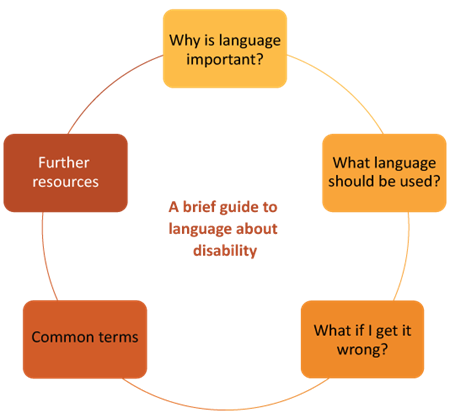A guide to language about disability
This brief guide to language about disability may be useful for career practitioners working with students with disability in educational settings. The guide explains key concepts and common terms and provides model sentences and conversation starters.

It was developed through research1 with students with disability, stakeholders and parents/carers into how to best support the career development learning (CDL) of students with disability.
Why is language important?
Language about disability is important because it portrays a person’s attitude and perception regarding disability.
Two main viewpoints of disability are the medical model of disability (where the disability is something to fix or cure) and the social model of disability (where society is not set up to accommodate difference).
Top Tip!
Watch this short video to learn about The Social Model of Disability.
When working with students with disability, use strengths-based language, not deficit language. Deficit language and thinking centres around what a person lacks or can’t do. Strengths-based language and thinking focuses on what a person can do, what qualities and resources they possess, and their strengths.
What language should be used?
Firstly, it is important for career practitioners to ask whether the student is comfortable discussing disability. For example, you could ask:
“Do you have any condition or disability that you think will impact the kind of job or career you’re interested in? Would you be okay with talking to me about this?”
Also, let the student know that they do not have to share anything about their disability or condition that they are not comfortable with. For example, you could say:
“You can tell me as much or as little about your condition or disability as you like. There is absolutely no pressure or requirement to disclose. My main priority is that you feel safe and comfortable talking to me and that we can give you the right kind of career advice.”
Until recently, people had been encouraged to use “person-first” language. This means that the person would be identified first in the sentence, then the disability. For example, “a person with autism”.
Increasingly, the disability community is claiming the word disability, or their specific disability, as part of their identity. For example, “I am autistic”. Others will be eligible for legal protections based on a condition they have, but they may not yet have a clearly formed identity related to disability.
Seek clarity around language from the students you work with as they will tell you which language they prefer.
If unsure, ask how the person would like you to refer to their disability. Open and respectful discussion helps build trust.
What if I get it wrong?
It is okay to be fearful about language; for example, you may wonder whether you are using the wrong terminology or whether your language is unintentionally offensive.
We are all learning. Let your student know that you are committed to their comfort. For example, you could say:
“I don’t have a lot of experience talking about this disability or condition. Please let me know if I say something that isn’t relevant or helpful.”
Common terms
- attention-deficit/hyperactivity disorder (ADHD): a neurodevelopmental disorder
- autism: a condition that affects how a person thinks, feels, interacts with others and experiences their environment
- chronic illness: long-lasting condition/s with persistent effects; often an invisible energy-limiting disability
- disability: can be described in a medical manner (e.g. a range of physical, intellectual, neurological, and psychiatric impairments2) or through the social model of disability, which asserts that society has a role in enabling people by providing supports to all
- dyslexia: unexpected and persistent challenge with acquiring and using written language
- dyspraxia: a disorder in which children do not develop the motor skills that are expected of their age
- Deaf/deaf: unable to hear or hard of hearing; note that the Deaf community often embraces the word Deaf as part of identity
- mental health condition: a wide range of conditions that may include schizophrenia, depression, bipolar disorder, post-traumatic stress disorder (PTSD), eating disorders (such as anorexia nervosa), anxiety and poorly-understood conditions referred to as personality disorders; the most common mental health conditions are depression, anxiety and substance-use disorder
- neurodiverse/neurodiversity: describes the diversity of human brain function within human society; includes neurotypical
- neurodivergent: an umbrella term for neurological differences such as ADHD, autism, dyslexia and dyspraxia where cognitive function diverges from the societal norm
- non-speaking: now used in preference to non-verbal; this term recognises various forms of verbal and non-verbal communication such as selective mutism and use of assistive technology to communicate
Terms to avoid
Avoid descriptions that suggest pity; for example, do not use “afflicted by,” “suffering from” or “victim”. Instead, use neutral language; for example “they have muscular dystrophy”.
Don’t describe a person as “being” their condition; for example, “Vanessa is paraplegic”. Instead, say “Vanessa has paraplegia”, unless the student uses identity-first language to describe themselves; for example, “Vanessa is Deaf”.
Further resources
Australian Federation of Disability Organisations Language Guide: https://www.afdo.org.au/news/language-guide
National Center on Disability and Journalism. Disability Language Style Guide: https://ncdj.org/style-guide
PWDA Language Guide: a guide to language about disability (2021): https://pwd.org.au/wp-content/uploads/2021/12/PWDA-Language-Guide-v2-2021.pdf
Walker, Nick. Neurodiversity: some basic terms and definitions: https://neuroqueer.com/neurodiversity-terms-and-definitions
Downloads
The above content is available for download as a Word and/or PDF document.
Download: Guide to language about disability (doc 2MB)
Download: Guide to language about disability (PDF)
A summary of the above content is also available as a PowerPoint presentation
Download: Guide to language about disability (pdf 1MB)
Download: Guide to language about disability (ppt 2.6MB)
1. Source: O’Shea et al. National Career Development Learning Hub for students with disability. National Careers Institute Partnership grant (2021–2023). The research involved interviews and surveys with students, parents/carers and stakeholders and analysis of existing data sets. Total participant responses = 774.
2. National Disability Services (n.d.). Disability Types and Description. https://www.nds.org.au/disability-types-and-descriptions

